

Gardening Fertilizer
By: Angela Gillaspie © 2005-2010
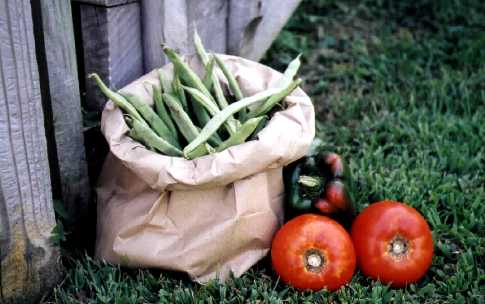
Deciding what to plant, when to plant it, and which plant to put it next to could be the difference between fat happy squash or shriveled sad squash.
Native Americans called beans, corn, and squash the "Three Sisters" and they planted one seed each of these in the same hole. Today's agriculturists call it the genius of the Indians. The corn stalks support the bean vines, squash leaves create shade and trap moisture, and the beans release nitrogen into the soil. Native Americans believed the Three Sisters reflected the physical and spiritual welfare of their people and provided sustenance of life. Myself, I like the Three Sisters cooked in bacon grease and served with cornbread.
A few of my favorite vegetables - corn, beans, tomatoes, peppers, potatoes, and onions - have some very interesting history and lore.
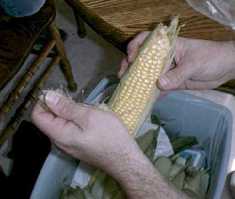
Corn. Native Americans told stories using corn to explain the creation of the world, plus they thought if women planted corn, there would be a healthier and bigger corn harvest. Yeah. How's that for tricking the wife to work in the field?
Also, Native Americans foretold the farmer's fate according to how the corn grew. For example, if the corn grew in straight rows and the cob was full of kernels, then the planter had excellent character and was truthful and thoughtful. When the rows of kernels were irregular and broken, then the planter was careless and thoughtless. If an ear of corn had scattered kernels, then this was a sign that the corn planter would live a long life and his or her teeth would be scattered like those kernels of corn. When the corn stalk had a bunch of small ears growing around the big ear of corn, then the farmer was to have a large and respectable family.
Granny always said that corn grew best with potatoes, peas, pumpkins, cucumbers, and obviously beans and squash. Corn should be planted when the dogwoods are in bloom and the poplar leaves are as big as squirrel ears.
If corn is planted under the new moon, most of the growing will be done at the tip of the ear, and corn planted under the waning moon will grow slower but produce larger ears. Oh, and if you laugh while planting corn, the kernels will have big gaps in them.
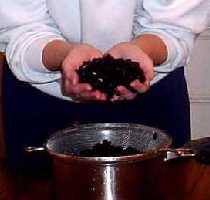
Beans. These are the magical fruit and are good for your heart, but in the 1800's, an interesting prediction was performed during Lent. A bean was placed in a pea pod, mixed in with other untouched pea pods, and then fried and served to unmarried people. The person that received the altered bean-pea pod would be the first to get married. Another folktale mentions if one bean in a hill of beans comes up white instead of green, there will be a death.
It's believed that May 3rd is the best day to plant beans. Also, after planting a hill of beans, press the soil with your foot - for better luck. Beans planted on dark nights will grow the best crops and beans planted early in the morning will be ready for picking earlier.
Tomato. Tomatoes are members of the mysterious nightshade family and one tale says that in the 1800's folks wouldn't eat tomatoes because they were feared to be poisonous. By 1840, Americans were addicted to tomatoes and thought they were medicinal. They made tomato pills to cure all kinds of ailments from acne to impotence. The French thought tomatoes had aphrodisiac qualities and called them "love apples" or "pommes d'amour."
Tomatoes should be planted on Memorial Day for a "memorable" crop and they grow best near onions, marigolds, carrots and cucumbers, but keep them away from fennel and Irish potatoes.
Pepper. Like tomatoes, peppers are members of the nightshade family, and have been used for more than just spicing up food over the centuries. One common household use was burning peppers to chase out pests ranging from bedbugs to mice. This pepper fumigation was used in ancient times to protect against vampires and werewolves. I bet it could be used nowadays to protect against door-to-door solicitors and evangelists trying to convert me. Smoke from burning peppers was used by South American tribes in warfare against Spanish invaders. These tribesmen also towed peppers behind their boats to ward off sharks.
To keep your mate faithful, tie together two dried Chile peppers with a red ribbon and place them under your pillow. It didn't say what to do if your mate found the ribbon-adorned peppers and asked questions. Crushed dried peppers scattered around the house will break any spells that someone might cast your way.
They say that redheaded gardeners grow hotter peppers. My Uncle Eustace mentioned, "To make your peppers hotter, plant 'em when you're really angry, and if you want big tasty peppers, get a lunatic to plant 'em!" I now understand why Uncle Eustace's peppers are so good.
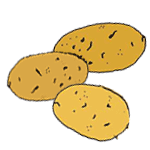
Potato. Like peppers, tomatoes, and mandrakes, potatoes are members of the nightshade family. With mandrakes being toxic, people also thought potatoes were poisonous. Matter of fact, the potato plant, green potatoes, and any sprouts from the tater's eyes are indeed toxic. Mandrake roots were thought to resemble humans and they supposedly let out a deadly scream when pulled from the ground. While potatoes don't quite resemble people, my momma had on occasion let out a deadly scream when I accidentally dug up a potato before it was tater diggin' time, so taters can be lethal.
Long ago, folks put slices of raw potato on broken bones, carried potatoes in their clothing to prevent rheumatism, and ate them with other foods to prevent indigestion. A peeled potato in the pocket supposedly cured a toothache. The Incas used potatoes to measure time - units of time were defined with how long it took the potato to cook. Speaking of cooked taters, Thomas Jefferson introduced French fries to America when he served them at a White House dinner.
Potatoes should be planted near beans and corn, and away from pumpkins, cucumbers, and sunflowers. They also should be planted during the dark phase of the moon at night so that the tater's eyes don't see any light. I'm still trying to figure out how the farmers saw to dig unless they had something to shade the tater's eyes.
Onion. The onion is a member of the lily family and is probably the most commonly eaten vegetable. Egyptians thought that onions represented eternal life and buried onions with each Pharaoh. It was believed that if one ate strong foods like onions, then one would become strong. With all the garlic, onions, and peppers that my daddy ate, it's no wonder why he could pick up a filing cabinet under each arm.
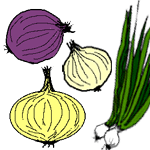
During the War Between the States, General Grant sent a note to the War Department that read, "I will not move my troops without onions," and he promptly received three cartloads. Grant also used onion juice to heal wounds. It makes you wonder how the war would've ended up if Grant didn't get his onion fix.
Raw onion was used to ease a toothache, bee stings, and burns. If you put onion juice on your head and then sit in the sun, it'll cure baldness. Nowadays, heart patients are advised to eat raw onions because they increase blood circulation and lower blood pressure. Also, onions contain a natural chemical that lowers cholesterol.
A Turkish legend said that when Satan was kicked out of heaven, garlic sprouted where he first placed his left foot, and onions grew where he placed his right foot. Maybe Satan's stinky foot is why onions make us cry when we chop them. Lore about preventing tears include: hold the non-striking end of a match in your teeth, wet your forearms with water, burn a candle to distract the onion, or even leave the root end attached while you chop. The best way to avoid weeping is to lightly freeze the onion and then chop it!
Onions should be planted during the "old" of the moon and away from beans and peas. If onion bulbs are planted upside down, they will come out in China.
Here is more gardening fertilizer:
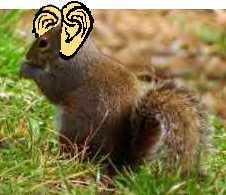
Okay, according to this gardening fertilizer, as soon as I get angry while planting my peppers, cry while planting my corn, and figure out the difference between a waning, waxing, and "old" moon, I should have a bountiful, beautiful, and bodacious harvest.
By the way, how big are squirrel's ears?
Stay tuned for more of Southern Angel's fun memoirs!
Click here to subscribe to Angel's Stories!